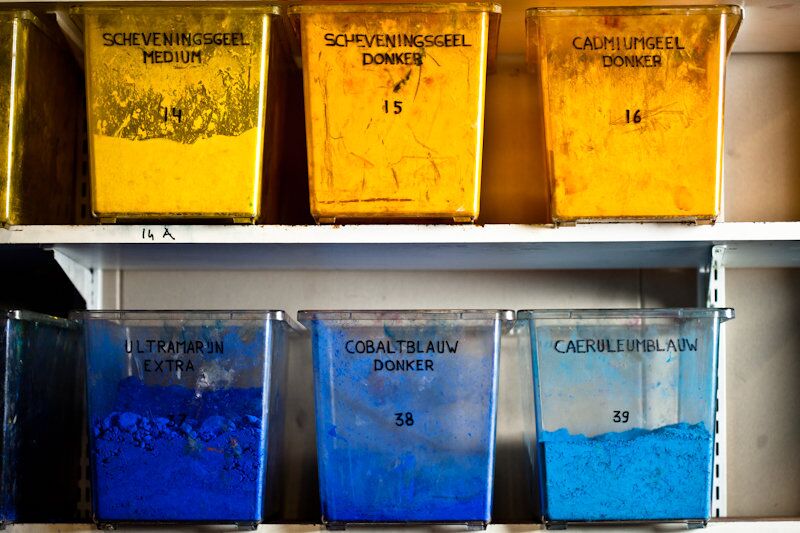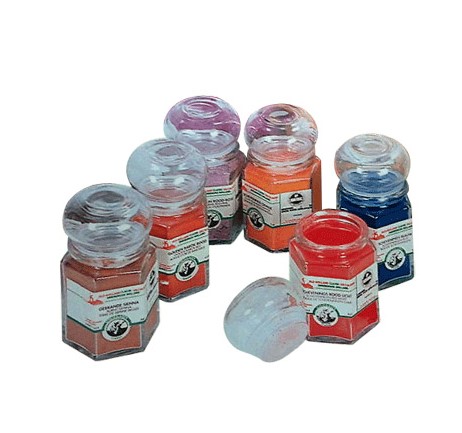
Everything you need to know about paint (part 2)
Brief overview of the most important characteristics of paint and pigments
click here for Everything you need to know about paint (part 1)
click here for Everything you need to know about paint (part 3)
Natural pigments
All pigments, and, accordingly, all the paints derived from them, can be divided into two main groups: natural ones and synthetic ones, and the former group can be further divided into organic and non-organic pigments.
Natural non-organic and mineral pigments
Natural non-organic and mineral pigments are, primarily, earth and stone. Among these earth-based natural pigments, used by artists ever since the Stone Age and beloved by artists of every era since then, right up until the present day, are ochre, which is not very bright, but has a pleasant tone. Its popularity can perhaps be attributed to the fact that nothing can top it when it comes to art that depicts the human body, and it is also resistant to light and moisture, even when mixed with other paints. There are various shades of ochre, depending on the iron content percentage and the degree of dispersion: light, dark, and golden. By burning ochre, red ochre can be obtained.
Similar to ochre in its chemical configuration and quality is natural sienna, which has a greenish tinge, but this color has a greater oil content than ochres, and therefore forms a less durable coat. Sienna is nonetheless cherished by artists for the beauty of its tone.
Besides ochre, the category of natural, earthy hues also includes brown mars (light and dark), natural and burnt umber, and Van Dyke brown. All of these pigments are notable for their durability and lightfastness; they behave well when mixed and combine well with all binders.
An immensely popular blue shade of mineral origin is ultramarine, which is obtained from lapis lazuli, a blue semi-precious stone. Ultramarine is completely water-resistant and light-resistant, contains not even a trace of moisture, and is extremely strong when mixed, as attested to by how well-preserved the bright-blue tones in Gothic art are. It is, however, sensitive to the effects of oxygen, and this leads to a loss of saturation and to the blue color in many works of art turning grey, a phenomenon that gallery staff have dubbed ‘ultramarine disease’. Ultramarine particles’ light refraction index is the same as those of oils and tar, and this weakens the paint’s saturation. The color properties of ultramarine are thus shown at their best when glue binders are used. Some artists, such as Van Dyke, wiped ultramarine with a binder. Natural ultramarine is extracted from the ground in Iran, China, Italy, Afghanistan, and Eastern Europe.

Natural organic pigments
Organic dyes, extracted from plants and insects since time immemorial, constitute another special group of paints. Unlike mineral pigments and synthetic pigments, they dissolve in water, spirit and oils. Since these dyes do not form a color layer, but rather penetrate deep into the fibers of the surface being painted, they are mainly used to paint fabrics. They are manufactured using organic dyes and paints. They are significantly more difficult to manufacture. To obtain a paint from mineral pigments, all that needs to be done is to mix it with any binder, which will then, as it dries out and partially evaporates, enable the film of paint to form. To obtain paints from organic dyes, on the other hand, the dyes are ground and strained using any base (chalk, kaolin, gypsum etc.), in combination with which they form an indissoluble dye.
The most widely-used organic paint is madder lake, which has been used for millennia and which is obtained from an extract from the roots of the Rubia tinctorum plant – a plant known as garance in French, Krapp in German and madder in English. When the extract is ground on a mineral base (alumina), a paint is obtained. The manufacture of paint from Rubia tinctorum was a technique known in ancient times.
Another dye that has a similar tone is carmine. This word can be used to refer to both the paint, and the natural dye. Among other synonyms, the following name is also used: ‘carmine lake’. Carmine dye is extracted from insects, specifically cactus parasites, that live on plants in America and bear the name ‘cochineal’. The terms carmine and cochineal are sometimes used as synonyms, therefore, in the literature.
Indigo, which is extracted from the plant woad, is in the category of plant-based blue dyes. Indigo was a very popular blue dye in Medieval times and during the Renaissance. From the 16th century onwards, it was widely used in painting. In the early 20th century, synthetic indigos started being manufactured, whose properties were just as good as those of natural indigo.
Prior to the emergence of synthetic pigments, artists’ color pallets were particularly deficient when it came to strong green hues. Pretty much the only one was the plant-based dye verdigris, which was used by the ancient Greeks and Romans. Verdigris had a whole host of negative characteristics, however. Firstly, it grew darker when mixed with other paints – with the exception of ochre. And it is for precisely this reason – the darkening of verdigris – that in the paintings of the Spanish, Italian and Dutch schools in the 16th-17th centuries, the green we see is not pure green, but rather a shade that is brownish-green or completely brown. Many of Leonardo da Vinci’s contemporaries attempted to attain a pure green color, by avoiding mixing verdigris with other paints, and trapping it between layers of varnish.
The dye takes on a beautiful light-brown tone thanks to the ink secreted by cephalopods such as the ‘sepia’ cuttlefish. Sepia has mainly been used in the production of watercolour paints. It has a low level of resistance to light. In the 19th century, sepia was one of the materials used for drawing, alongside sangine and bistro.
Stone Age artists created drawings on cave walls and cliff-faces using only natural, earthy pigments. By the time of the Ancient Egyptians, synthetic pigments were already being used. Thanks to calcination, ochres, umbras and siennas took on new shades. Thereafter, the number of synthetic pigments steadily rose, and their number increased particularly noticeably in the 19th century, thanks to advances in chemistry and production techniques.







